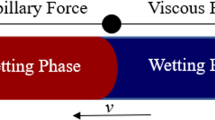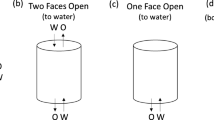Abstract
We present guidelines for accurately simulating both co- and counter-current spontaneous imbibition (SI) phenomenon in 1D systems. We first consider several cases for this study, which involve strongly water-wet, weakly water-wet and mixed-wet wettability states, to simulate co- and counter-current SI in an oil–water system. We create two separate 1D models on a numerical simulator to simulate and obtain saturation profiles for the different cases. We then match simulation results with saturation profiles obtained through the capillary dominated flow semi-analytical solution proposed by Schmid et al. (Water Resour Res 47(2), 2011, SPE J 21:2–308, 2016). The numerical study evaluates the effect of model orientation and co-ordinate system on the saturation profiles. Moreover, we perform grid sensitivity analysis to choose the optimal number of grid cells, as well as the optimal time steps for the model. We find that capturing 0.25% of core volume in each grid cell is sufficient to numerically model an SI experiment within the acceptable margin of error of 5%. Simulations are performed for 23 different cases based on the SI mode, wettability and mobility ratios. The simulation results in saturation profiles have a mean absolute percentage error from the profile obtained from the semi-analytical solution between 0.14 and 5.41% for counter-current SI for the different wettability states. For most wettability states for the co-current SI, however, we do not get a close match, indicating that the semi-analytical solution does not hold for co-current SI. The paper lists some useful guidelines for simulating SI phenomenon, such as selecting the optimum number of grid cells for the SI model and accounting for capillary backpressure, which could be extended to be applied for simulating coreflooding experiments. This paper also discusses current limitations of the semi-analytical solution. These calibration and sensitivity studies can significantly improve the accuracy of the simulation results.




















Similar content being viewed by others
Abbreviations
- F :
-
Capillary dominated fractional flow
- F′:
-
First derivative of F
- F″:
-
Second derivative of F
- f :
-
Buckley–Leverett fractional flow
- ɸ :
-
Porosity
- C :
-
Imbibition constant (m/√s)
- D :
-
Capillary dispersion coefficient (m2/s)
- k :
-
Permeability (m2)
- λ w :
-
Water mobility (1/Pa s)
- λ o :
-
Oil mobility (1/Pa s)
- λ t :
-
Total mobility (1/Pa s)
- dP c /dx :
-
Capillary pressure gradient (Pa/m)
- q w :
-
Water flow rate (m3/s)
- q o :
-
Oil flow rate (m3/s)
- k rw :
-
Water relative permeability
- k ro :
-
Oil relative permeability
- k rw max :
-
Maximum water relative permeability
- k ro max :
-
Maximum oil relative permeability
- S w :
-
Water saturation
- S *w :
-
Water saturation when capillary pressure is zero
- S o :
-
Oil saturation
- S wi :
-
Initial water saturation
- S or :
-
Residual oil saturation
- P c :
-
Capillary pressure (Pa)
- RF:
-
Recovery factor
- P c :
-
Capillary pressure (Pa)
- P entry :
-
Entry capillary pressure (Pa)
- P cb :
-
Capillary back pressure (Pa)
- n :
-
Wetting phase exponent
- m :
-
Non-wetting phase exponent
- l :
-
Capillary pressure exponent
- A t :
-
Actual value
- F t :
-
Forecast value
- n i :
-
Total number of data points
- t :
-
Time (s)
- x :
-
Distance in the core (m)
- ω :
-
Scaling factor (m/√s)
References
Akin, S., Schembre, J.M., Bhat, S.K., Kovscek, A.R.: Spontaneous imbibition characteristics of diatomite. J. Petrol. Sci. Eng. 25(3), 149–165 (2000)
Alyafei, N., Al-Menhali, A., Blunt, M.J.: Experimental and analytical investigation of spontaneous imbibition in water-wet carbonates. Transp. Porous Media 115(1), 189–207 (2016)
Alyafei, N., Blunt, M.J.: Estimation of relative permeability and capillary pressure from mass imbibition experiments. Adv. Water Resour. 115, 88–94 (2018)
Andersen, P.Ø., Brattekås, B., Walrond, K., Aisyah, D.S., Nødland, O., Lohne, A., Haugland, H., Føyen, T.L., Fernø, M.A.: Numerical interpretation of laboratory spontaneous imbibition-incorporation of the capillary back pressure and how it affects SCAL. In: SPE Abu Dhabi International Petroleum Exhibition & Conference. Society of Petroleum Engineers (2017)
Andersen, P.Ø., Qiao, Y., Standnes, D.C., Evje, S.: Co-current spontaneous imbibition in porous media with the dynamics of viscous coupling and capillary back pressure. In: SPE Improved Oil Recovery Conference. Society of Petroleum Engineers (2018)
Armstrong, J.S., Forecasting, L.R.: From crystal ball to computer. New York ua (1985)
Behbahani, H., Blunt, M.J.: Analysis of imbibition in mixed-wet rocks using pore-scale modeling. SPE J. 10(04), 466–474 (2005)
Behbahani, H.S., Di Donato, G., Blunt, M.J.: Simulation of counter-current imbibition in water-wet fractured reservoirs. J. Petrol. Sci. Eng. 50(1), 21–39 (2006)
Blunt, M.J.: Multiphase flow in permeable media: a pore-scale perspective. Cambridge University Press, Cambridge (2017)
Buckley, S.E., Leverett, M.: Mechanism of fluid displacement in sands. Trans. AIME 146(01), 107–116 (1942)
Chen, Z.X., Bodvarsson, G.S., Witherspoon, P.A.: Comment on “Exact integral solutions for two-phase flow” by David B. McWhorter and Daniel K. Sunada. Water Resour. Res. 28(5), 1477–1478 (1992)
Cil, M., Reis, J.C.: A multi-dimensional, analytical model for counter-current water imbibition into gas-saturated matrix blocks. J. Petrol. Sci. Eng. 16(1–3), 61–69 (1996)
Evans, C.E., Guerrero, E.T.: Theory and application of capillary pressure. In: SPWLA 20th annual logging symposium. Society of Petrophysicists and Well-Log Analysts (1979)
Fernø, M.A., Haugen, Å., Mason, G., Morrow, N.R.: Measurement of core properties using a new technique–two ends open spontaneous imbibition. In: Proceedings of Society of Core Analysts held in Avignon, France (2014)
Foley, A.Y., Nooruddin, H.A., Blunt, M.J.: The impact of capillary backpressure on spontaneous counter-current imbibition in porous media. Adv. Water Resour. 107, 405–420 (2017)
Haugen, Å., Fernø, M.A., Mason, G., Morrow, N.R.: Capillary pressure and relative permeability estimated from a single spontaneous imbibition test. J. Petrol. Sci. Eng. 115, 66–77 (2014)
Kashchiev, D., Firoozabadi, A.: Analytical solutions for 1D countercurrent imbibition in water-wet media. SPE J. 8(04), 401–408 (2003)
Khan, A.S., Alyafei, N.: Investigation of an analytical solution for spontaneous imbibition to effectively estimate special core analysis SCAL properties (Russian). In: SPE Annual Caspian Technical Conference and Exhibition. Society of Petroleum Engineers (2017)
Li, K., Horne, R.N.: Characterization of spontaneous water imbibition into gas-saturated rocks. In: SPE/AAPG Western Regional Meeting. Society of Petroleum Engineers (2000)
Li, K., Horne, R.N.: Generalized scaling approach for spontaneous imbibition: an analytical model. SPE Reserv. Eval. Eng. 9(03), 251–258 (2006)
Mason, G., Fischer, H., Morrow, N.R., Johannesen, E., Haugen, Å., Graue, A., Fernø, M.A.: Oil production by spontaneous imbibition from sandstone and chalk cylindrical cores with two ends open. Energy Fuels 24(2), 1164–1169 (2010)
Mason, G., Morrow, N.R.: Developments in spontaneous imbibition and possibilities for future work. J. Petrol. Sci. Eng. 110, 268–293 (2013)
McWhorter, D.B., Sunada, D.K.: Exact integral solutions for two-phase flow. Water Resour. Res. 26(3), 399–413 (1990)
McWhorter, D.B., Sunada, D.K.: Reply [to “Comment on ‘Exact integral solutions for two-phase flow’ by David B. McWhorter and Daniel K. Sunada”]. Water Resour. Res. 28(5), 1479 (1992)
Morrow, N.R., Mason, G.: Recovery of oil by spontaneous imbibition. Curr. Opin. Colloid Interface Sci. 6(4), 321–337 (2001)
Nooruddin, H.A., Blunt, M.J.: Analytical and numerical investigations of spontaneous imbibition in porous media. Water Resour. Res. 52(9), 7284–7310 (2016)
Pooladi-Darvish, M., Firoozabadi, A.: Cocurrent and countercurrent imbibition in a water-wet matrix block. SPE J. 5(01), 3–11 (2000)
Qi, R., LaForce, T.C., Blunt, M.J.: Design of carbon dioxide storage in aquifers. Int. J. Greenh. Gas Control. 3(2), 195–205 (2009)
Ruth, D.W., Mason, G., Fernø, M.A., Haugen, Å., Morrow, N.R., Arabjamaloei, R.: Numerical simulation of combined co-current/counter-current spontaneous imbibition. In: International Symposium of the Society of Core Analysts, pp. 16–21 (2015)
Schembre, J., Akin, S., Kovscek, A.R.: Spontaneous imbibition in low permeability media. Doctoral dissertation, Stanford University (1998)
Schmid, K.S., Geiger, S., Sorbie, K.S.: Semianalytical solutions for cocurrent and countercurrent imbibition and dispersion of solutes in immiscible two-phase flow. Water Resour. Res. 47(2), W02550 (2011)
Schmid, K.S., Geiger, S.: Universal scaling of spontaneous imbibition for water-wet systems. Water Resour. Res. 48(3), W03507 (2012)
Schmid, K.S., Geiger, S.: Universal scaling of spontaneous imbibition for arbitrary petrophysical properties: water-wet and mixed-wet states and Handy’s conjecture. J. Petrol. Sci. Eng. 101, 44–61 (2013)
Schmid, K.S., Alyafei, N., Geiger, S., Blunt, M.J.: Analytical solutions for spontaneous imbibition: fractional-flow theory and experimental analysis. SPE J. (2016). https://doi.org/10.2118/184393-PA
Suzanne, K., Hamon, G., Billiotte, J., Trocme, V.: Experimental relationships between residual gas saturation and initial gas saturation in heterogeneous sandstone reservoirs. In: SPE Annual Technical Conference and Exhibition. Society of Petroleum Engineers (2003)
Unsal, E., Mason, G., Morrow, N.R., Ruth, D.W.: Co-current and counter-current imbibition in independent tubes of non-axisymmetric geometry. J. Colloid Interface Sci. 306(1), 105–117 (2007)
Yortsos, Y.C., Fokas, A.S.: An analytical solution for linear waterflood including the effects of capillary pressure. Soc. Petrol. Eng. J. 23(01), 115–124 (1983)
Zhang, X., Morrow, N.R., Ma, S.: Experimental verification of a modified scaling group for spontaneous imbibition. SPE Reserv. Eng. 11(04), 280–285 (1996)
Acknowledgements
We would like to thank Texas A&M University at Qatar for funding this project. In addition, we would like to thank Prof. Martin J. Blunt for his insightful comments and suggestions.
Author information
Authors and Affiliations
Corresponding author
Rights and permissions
About this article
Cite this article
Khan, A.S., Siddiqui, A.R., Abd, A.S. et al. Guidelines for Numerically Modeling Co- and Counter-current Spontaneous Imbibition. Transp Porous Med 124, 743–766 (2018). https://doi.org/10.1007/s11242-018-1093-3
Received:
Accepted:
Published:
Issue Date:
DOI: https://doi.org/10.1007/s11242-018-1093-3




